P-type (CuTi)Ox Thin Films Deposited by Magnetron Co-Sputtering and Their Electronic and Hydrogen Sensing Properties
Abstract
1. Introduction
2. Materials and Methods
3. Results
3.1. Microstructure and Morphology
3.2. Electrical and Optical Properties
3.3. Hydrogen Gas Sensing
4. Summary
Author Contributions
Funding
Institutional Review Board Statement
Informed Consent Statement
Data Availability Statement
Acknowledgments
Conflicts of Interest
References
- Wojcieszak, D.; Domaradzki, J.; Mazur, M.; Kotwica, T.; Kaczmarek, D. Investigation of a Memory Effect in a Au/(Ti–Cu)Ox-Gradient Thin Film/TiAlV Structure. Beilstein J. Nanotechnol. 2022, 13, 265–273. [Google Scholar] [CrossRef] [PubMed]
- Wojcieszak, D.; Mazur, M.; Kaczmarek, D.; Poniedziałek, A.; Osekowska, M. An Impact of the Copper Additive on Photocatalytic and Bactericidal Properties of TiO2 Thin Films. Mater. Sci. Pol. 2017, 35, 421–426. [Google Scholar] [CrossRef]
- Domaradzki, J. Perspectives of Development of TCO and TOS Thin Films Based on (Ti-Cu)Oxide Composites. Surf. Coatings Technol. 2016, 290, 28–33. [Google Scholar] [CrossRef]
- Nakata, K.; Fujishima, A. TiO2 Photocatalysis: Design and Applications. J. Photochem. Photobiol. C Photochem. Rev. 2012, 13, 169–189. [Google Scholar] [CrossRef]
- Livage, J.; Ganguli, D. Sol-Gel Electrochromic Coatings and Devices: A Review. Sol. Energy Mater. Sol. Cells 2001, 68, 365–381. [Google Scholar] [CrossRef]
- Maziarz, W. TiO2/SnO2 and TiO2/CuO Thin Film Nano-Heterostructures as Gas Sensors. Appl. Surf. Sci. 2019, 480, 361–370. [Google Scholar] [CrossRef]
- Nunes, D.; Pimentel, A.; Goncalves, A.; Pereira, S.; Branquinho, R.; Barquinha, P.; Fortunato, E.; Martins, R. Metal Oxide Nanostructures for Sensor Applications. Semicond. Sci. Technol. 2019, 34, 043001. [Google Scholar] [CrossRef]
- Wojcieszak, D.; Obstarczyk, A.; Mańkowska, E.; Mazur, M.; Kaczmarek, D.; Zakrzewska, K.; Mazur, P.; Domaradzki, J. Thermal Oxidation Impact on the Optoelectronic and Hydrogen Sensing Properties of P-Type Copper Oxide Thin Films. Mater. Res. Bull. 2022, 147, 111646. [Google Scholar] [CrossRef]
- Wiatrowski, A.; Wojcieszak, D.; Mazur, M.; Kaczmarek, D.; Domaradzki, J.; Kalisz, M.; Kijaszek, W.; Pokora, P.; Mańkowska, E.; Lubanska, A.; et al. Photocatalytic Coatings Based on TiOx for Application on Flexible Glass for Photovoltaic Panels. J. Mater. Eng. Perform. 2022, 31, 6998–7008. [Google Scholar] [CrossRef]
- Zoolfakar, A.S.; Rani, R.A.; Morfa, A.J.; O’Mullane, A.P.; Kalantar-Zadeh, K. Nanostructured Copper Oxide Semiconductors: A Perspective on Materials, Synthesis Methods and Applications. J. Mater. Chem. C 2014, 2, 5247–5270. [Google Scholar] [CrossRef]
- Dahl, M.; Liu, Y.; Yin, Y. Composite Titanium Dioxide Nanomaterials. Chem. Rev. 2014, 114, 9853–9889. [Google Scholar] [CrossRef]
- Rydosz, A. The Use of Copper Oxide Thin Films in Gas-Sensing Applications. Coatings 2018, 8, 425. [Google Scholar] [CrossRef]
- Barreca, D.; Battiston, G.A.; Casellato, U.; Gerbasi, R.; Tondello, E. Low Pressure CVD of Transparent Cu-Al-O and Cu-Ti-O Thin Films. J. Phys. IV 2001, 11, Pr11-253. [Google Scholar] [CrossRef]
- Wang, Z.; Nayak, P.K.; Caraveo-Frescas, J.A.; Alshareef, H.N. Recent Developments in P-Type Oxide Semiconductor Materials and Devices. Adv. Mater. 2016, 28, 3831–3892. [Google Scholar] [CrossRef]
- Mor, G.K.; Varghese, O.K.; Wilke, R.H.T.; Sharma, S.; Shankar, K.; Latempa, T.J.; Choi, K.S.; Grimes, C.A. P-Type Cu-Ti-O Nanotube Arrays and Their Use in Self-Biased Heterojunction Photoelectrochemical Diodes for Hydrogen Generation. Nano Lett. 2008, 8, 1906–1911. [Google Scholar] [CrossRef]
- Fortunato, E.; Figueiredo, V.; Barquinha, P.; Elamurugu, E.; Barros, R.; Goņalves, G.; Park, S.H.K.; Hwang, C.S.; Martins, R. Thin-Film Transistors Based on p-Type Cu2O Thin Films Produced at Room Temperature. Appl. Phys. Lett. 2010, 96, 2–5. [Google Scholar] [CrossRef]
- Mazur, M.; Wojcieszak, D.; Domaradzki, J.; Kaczmarek, D.; Song, S.; Placido, F. TiO2/SiO2 Multilayer as an Antireflective and Protective Coating Deposited by Microwave Assisted Magnetron Sputtering. Opto-Electron. Rev. 2013, 21, 233–238. [Google Scholar] [CrossRef]
- Nair, P.B.; Justinvictor, V.B.; Daniel, G.P.; Joy, K.; Ramakrishnan, V.; Thomas, P.V. Effect of RF Power and Sputtering Pressure on the Structural and Optical Properties of TiO2 Thin Films Prepared by RF Magnetron Sputtering. Appl. Surf. Sci. 2011, 257, 10869–10875. [Google Scholar] [CrossRef]
- Domaradzki, J.; Wiatrowski, A.; Kotwica, T.; Mazur, M. Analysis of Electrical Properties of Forward-to-Open (Ti,Cu)Ox Memristor Rectifier with Elemental Gradient Distribution Prepared Using (Multi)Magnetron Co-Sputtering Process. Mater. Sci. Semicond. Process. 2019, 94, 9–14. [Google Scholar] [CrossRef]
- Zhang, W.; Li, Y.; Zhu, S.; Wang, F. Copper Doping in Titanium Oxide Catalyst Film Prepared by Dc Reactive Magnetron Sputtering. Catal. Today 2004, 93–95, 589–594. [Google Scholar] [CrossRef]
- Torrisi, A.; Horák, P.; Vacík, J.; Cannavò, A.; Ceccio, G.; Yatskiv, R.; Kupcik, J.; Fara, J.; Fitl, P.; Vlcek, J.; et al. Preparation of Heterogenous Copper-Titanium Oxides for Chemiresistor Applications. Mater. Today Proc. 2019, 33, 2512–2516. [Google Scholar] [CrossRef]
- Torrisi, A.; Ceccio, G.; Cannav, A.; Lavrentiev, V.; Hor, P.; Yatskiv, R.; Vaniš, J.; Grym, J.; Fišer, L.; Hruška, M. Chemiresistors Based on Li-Doped CuO-TiO2 Films. Chemosensors 2021, 9, 246. [Google Scholar] [CrossRef]
- Barreca, D.; Carraro, G.; Comini, E.; Gasparotto, A.; MacCato, C.; Sada, C.; Sberveglieri, G.; Tondello, E. Novel Synthesis and Gas Sensing Performances of CuO-TiO2 Nanocomposites Functionalized with Au Nanoparticles. J. Phys. Chem. C 2011, 115, 10510–10517. [Google Scholar] [CrossRef]
- Kubiak, A.; Bielan, Z.; Kubacka, M.; Gabała, E.; Zgoła-Grześkowiak, A.; Janczarek, M.; Zalas, M.; Zielińska-Jurek, A.; Siwińska-Ciesielczyk, K.; Jesionowski, T. Microwave-Assisted Synthesis of a TiO2-CuO Heterojunction with Enhanced Photocatalytic Activity against Tetracycline. Appl. Surf. Sci. 2020, 520, 146344. [Google Scholar] [CrossRef]
- Ma, Q.; Liu, S.J.; Weng, L.Q.; Liu, Y.; Liu, B. Growth, Structure and Photocatalytic Properties of Hierarchical Cu-Ti-O Nanotube Arrays by Anodization. J. Alloys Compd. 2010, 501, 333–338. [Google Scholar] [CrossRef]
- Zhao, Z.; Sun, J.; Zhang, G.; Bai, L. The Study of Microstructure, Optical and Photocatalytic Properties of Nanoparticles(NPs)-Cu/TiO2 Films Deposited by Magnetron Sputtering. J. Alloys Compd. 2015, 652, 307–312. [Google Scholar] [CrossRef]
- Fouad, S.S.; Baradács, E.; Nabil, M.; Parditka, B.; Negm, S.; Erdélyi, Z. Microstructural and Optical Duality of TiO2/Cu/TiO2 Trilayer Films Grown by Atomic Layer Deposition and DC Magnetron Sputtering. Inorg. Chem. Commun. 2022, 145, 110017. [Google Scholar] [CrossRef]
- Mekasuwandumrong, O.; Jantarasorn, N.; Panpranot, J.; Ratova, M.; Kelly, P.; Praserthdam, P. Synthesis of Cu/TiO2 Catalysts by Reactive Magnetron Sputtering Deposition and Its Application for Photocatalytic Reduction of CO2 and H2O to CH4. Ceram. Int. 2019, 45, 22961–22971. [Google Scholar] [CrossRef]
- Zong, M.; Bai, L.; Liu, Y.; Wang, X.; Zhang, X.; Huang, X.; Hang, R.; Tang, B. Antibacterial Ability and Angiogenic Activity of Cu-Ti-O Nanotube Arrays. Mater. Sci. Eng. C 2017, 71, 93–99. [Google Scholar] [CrossRef]
- Pai, M.R.; Banerjee, A.M.; Rawool, S.A.; Singhal, A.; Nayak, C.; Ehrman, S.H.; Tripathi, A.K.; Bharadwaj, S.R. A Comprehensive Study on Sunlight Driven Photocatalytic Hydrogen Generation Using Low Cost Nanocrystalline Cu-Ti Oxides. Sol. Energy Mater. Sol. Cells 2016, 154, 104–120. [Google Scholar] [CrossRef]
- Manjunath, K.; Souza, V.S.; Ramakrishnappa, T.; Nagaraju, G.; Scholten, J.D.; Dupont, J. Heterojunction CuO-TiO2 Nanocomposite Synthesis for Significant Photocatalytic Hydrogen Production. Mater. Res. Express 2016, 3, 115704. [Google Scholar] [CrossRef]
- Wang, Z.; Liu, Y.; Martin, D.J.; Wang, W.; Tang, J.; Huang, W. CuOx-TiO2 Junction: What Is the Active Component for Photocatalytic H2 Production? Phys. Chem. Chem. Phys. 2013, 15, 14956–14960. [Google Scholar] [CrossRef] [PubMed]
- Sreedhar, M.; Reddy, I.N.; Bera, P.; Ramachandran, D.; Gobi Saravanan, K.; Rabel, A.M.; Anandan, C.; Kuppusami, P.; Brijitta, J. Cu/TiO2 Thin Films Prepared by Reactive RF Magnetron Sputtering. Appl. Phys. A Mater. Sci. Process. 2015, 120, 765–773. [Google Scholar] [CrossRef]
- Mazur, M.; Domaradzki, J.; Wojcieszak, D.; Kaczmarek, D. Investigations of Elemental Composition and Structure Evolution in (Ti,Cu)-Oxide Gradient Thin Films Prepared Using (Multi)Magnetron Co-Sputtering. Surf. Coatings Technol. 2018, 334, 150–157. [Google Scholar] [CrossRef]
- Kotwica, T.; Domaradzki, J.; Wojcieszak, D.; Sikora, A.; Kot, M.; Schmeisser, D. Analysis of Surface Properties of Ti-Cu-Ox Gradient Thin Films Using AFM and XPS Investigations. Mater. Sci. Pol. 2018, 36, 761–768. [Google Scholar] [CrossRef]
- Torrisi, A.; Horák, P.; Vacík, J.; Cannavò, A.; Ceccio, G.; Vaniš, J.; Yatskiv, R.; Grym, J. Multilayered Cu–Ti Deposition on Silicon Substrates for Chemiresistor Applications. Sulfur Silicon Relat. Elem. 2020, 195, 932–935. [Google Scholar] [CrossRef]
- Barreca, D.; Carraro, G.; Gasparotto, A.; MacCato, C.; Cruz-Yusta, M.; Gómez-Camer, J.L.; Morales, J.; Sada, C.; Sánchez, L. On the Performances of CuxO-TiO2 (x = 1, 2) Nanomaterials as Innovative Anodes for Thin Film Lithium Batteries. ACS Appl. Mater. Interfaces 2012, 4, 3610–3619. [Google Scholar] [CrossRef]
- Horzum, S.; Gürakar, S.; Serin, T. Investigation of the Structural and Optical Properties of Copper-Titanium Oxide Thin Films Produced by Changing the Amount of Copper. Thin Solid Films 2019, 685, 293–298. [Google Scholar] [CrossRef]
- PDF Card 04-0836; Powder Diffraction File, Joint Commiittee on Powder Diffraction Standards. ASTM: Philadelphia, PA, USA.
- PDF Card 65-3288; Powder Diffraction File, Joint Commiittee on Powder Diffraction Standards. ASTM: Philadelphia, PA, USA.
- PDF Card 65-2309; Powder Diffraction File, Joint Commiittee on Powder Diffraction Standards. ASTM: Philadelphia, PA, USA.
- PDF Card 65-2900; Powder Diffraction File, Joint Commiittee on Powder Diffraction Standards. ASTM: Philadelphia, PA, USA.
- PDF Card 21-1272; Powder Diffraction File, Joint Commiittee on Powder Diffraction Standards. ASTM: Philadelphia, PA, USA.
- Holzwarth, U.; Gibson, N. The Scherrer Equation versus the “Debye-Scherrer Equation”. Nat. Nanotechnol. 2011, 6, 534. [Google Scholar] [CrossRef]
- Goto, T.; Li, J.H.; Hirai, T.; Maeda, Y.; Kato, R.; Maesono, A. Measurements of the Seebeck Coefficient of Thermoelectric Materials by an AC Method. Int. J. Thermophys. 1997, 18, 569–577. [Google Scholar] [CrossRef]
- Kelkar, G.P.; Carim, A.H. Synthesis, Properties, and Ternary Phase Stability of M6X Compounds in the Ti—Cu—O System. J. Am. Ceram. Soc. 1993, 76, 1815–1820. [Google Scholar] [CrossRef]
- Hickman, J.; Gulbransen, E. Oxide Films Formed on Titanium, Zirconia, and Their Alloys with Nickel, Copper, and Cobalt. Anal. Chem. 1948, 20, 158–165. [Google Scholar] [CrossRef]
- Park, S.; Kim, S.; Kheel, H.; Park, S.E.; Lee, C. Synthesis and Hydrogen Gas Sensing Properties of TiO2-Decorated CuO Nanorods. Bull. Korean Chem. Soc. 2015, 36, 2458–2463. [Google Scholar] [CrossRef]
- Wang, H.; Li, Y.; Ba, X.; Huang, L.; Yu, Y. TiO2 Thin Films with Rutile Phase Prepared by DC Magnetron Co-Sputtering at Room Temperature: Effect of Cu Incorporation. Appl. Surf. Sci. 2015, 345, 49–56. [Google Scholar] [CrossRef]
- Banakh, O.; Schmid, P.E.; Sanjines, R.; Levy, F. Electrical and Optical Properties of TiOx Thin Films Deposited by Reactive Magnetron Sputtering. Surf. Coatings Technol. 2002, 151, 272–275. [Google Scholar] [CrossRef]
- Assim, E.M. Optical Constants of Titanium Monoxide TiO Thin Films. J. Alloys Compd. 2008, 465, 1–7. [Google Scholar] [CrossRef]
- Grigorov, K.G.; Grigorov, G.I.; Drajeva, L.; Bouchier, D.; Sporken, R.; Caudano, R. Synthesis and Characterization of Conductive Titanium Monoxide Films. Diffusion of Silicon in Titanium Monoxide Films. Vacuum 1998, 51, 153–155. [Google Scholar] [CrossRef]
- Wei, Y.; Shi, Y.; Zhang, X.; Li, D.; Zhang, L.; Gong, C.; Zhang, J. Preparation of Black Titanium Monoxide Nanoparticles and Their Potential in Electromagnetic Wave Absorption. Adv. Powder Technol. 2020, 31, 3458–3464. [Google Scholar] [CrossRef]
- Nguyen, T.T.N.; Chen, Y.H.; He, J.L. Preparation of Inkjet-Printed Titanium Monoxide as p-Type Absorber Layer for Photovoltaic Purposes. Thin Solid Films 2014, 572, 8–14. [Google Scholar] [CrossRef]
- Domaradzki, J.; Kaczmarek, D.; Prociow, E.L.; Radzimski, Z.J. Study of Structure Densification in TiO2 Coatings Prepared by Magnetron Sputtering under Low Pressure of Oxygen Plasma Discharge. Acta Phys. Pol. A 2011, 120, 49–52. [Google Scholar] [CrossRef]
- Ju, Y.; Li, L.; Wu, Z.; Jiang, Y. Effect of Oxygen Partial Pressure on the Optical Property of Amorphous Titanium Oxide Thin Films. Energy Procedia 2011, 12, 450–455. [Google Scholar] [CrossRef]
- Figueiredo, V.; Elangovan, E.; Gonçalves, G.; Barquinha, P.; Pereira, L.; Franco, N.; Alves, E.; Martins, R.; Fortunato, E. Effect of Post-Annealing on the Properties of Copper Oxide Thin Films Obtained from the Oxidation of Evaporated Metallic Copper. Appl. Surf. Sci. 2008, 254, 3949–3954. [Google Scholar] [CrossRef]
- Miller, D.R.; Akbar, S.A.; Morris, P.A. Nanoscale Metal Oxide-Based Heterojunctions for Gas Sensing: A Review. Sens. Actuators B Chem. 2014, 204, 250–272. [Google Scholar] [CrossRef]
- Barsan, N.; Weimar, U. Conduction Model of Metal Oxide Gas Sensors. J. Electroceramics 2001, 7, 143–167. [Google Scholar] [CrossRef]
- Lyson-Sypien, B.; Radecka, M.; Rekas, M.; Swierczek, K.; Michalow-Mauke, K.; Graule, T.; Zakrzewska, K. Grain-Size-Dependent Gas-Sensing Properties of TiO2 Nanomaterials. Sens. Actuators B Chem. 2015, 211, 67–76. [Google Scholar] [CrossRef]
- Rydosz, A.; Czapla, A.; Maziarz, W.; Zakrzewska, K.; Brudnik, A. CuO and CuO/TiO2-y Thin-Film Gas Sensors of H2 and NO2. In Proceedings of the 2018 XV International Scientific Conference on Optoelectronic and Electronic Sensors (COE), Warsaw, Poland, 17–20 June 2018; pp. 2016–2019. [Google Scholar] [CrossRef]
- Hübner, M.; Simion, C.E.; Tomescu-Stǎnoiu, A.; Pokhrel, S.; Bârsan, N.; Weimar, U. Influence of Humidity on CO Sensing with P-Type CuO Thick Film Gas Sensors. Sens. Actuators B Chem. 2011, 153, 347–353. [Google Scholar] [CrossRef]
- Alev, O.; Şennik, E.; Öztürk, Z.Z. Improved Gas Sensing Performance of P-Copper Oxide Thin Film/n-TiO2 Nanotubes Heterostructure. J. Alloys Compd. 2018, 749, 221–228. [Google Scholar] [CrossRef]
- Kosc, I.; Hotovy, I.; Rehacek, V.; Griesseler, R.; Predanocy, M.; Wilke, M.; Spiess, L. Sputtered TiO2 Thin Films with NiO Additives for Hydrogen Detection. Appl. Surf. Sci. 2013, 269, 110–115. [Google Scholar] [CrossRef]
- Lupan, O.; Santos-Carballal, D.; Ababii, N.; Magariu, N.; Hansen, S.; Vahl, A.; Zimoch, L.; Hoppe, M.; Pauporté, T.; Galstyan, V.; et al. TiO2/Cu2O/CuO Multi-Nanolayers as Sensors for H2 and Volatile Organic Compounds: An Experimental and Theoretical Investigation. ACS Appl. Mater. Interfaces 2021, 13, 32363–32380. [Google Scholar] [CrossRef]
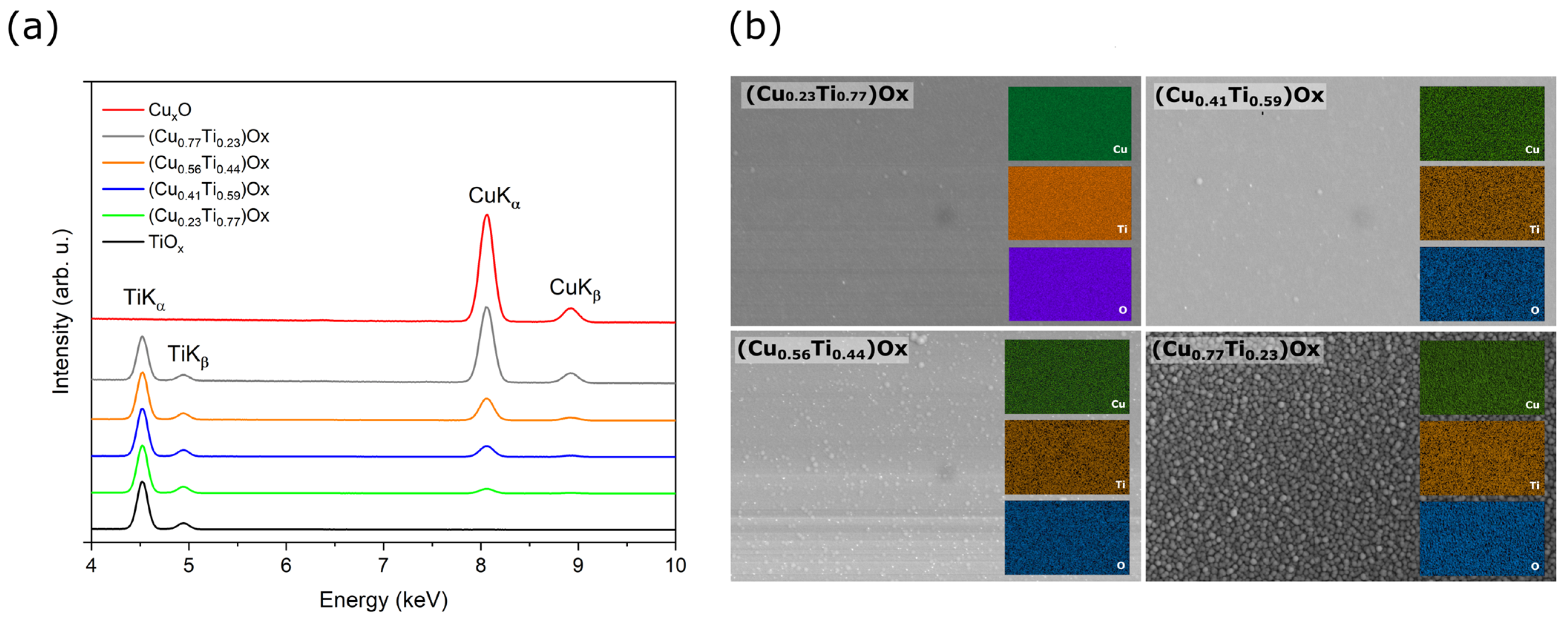
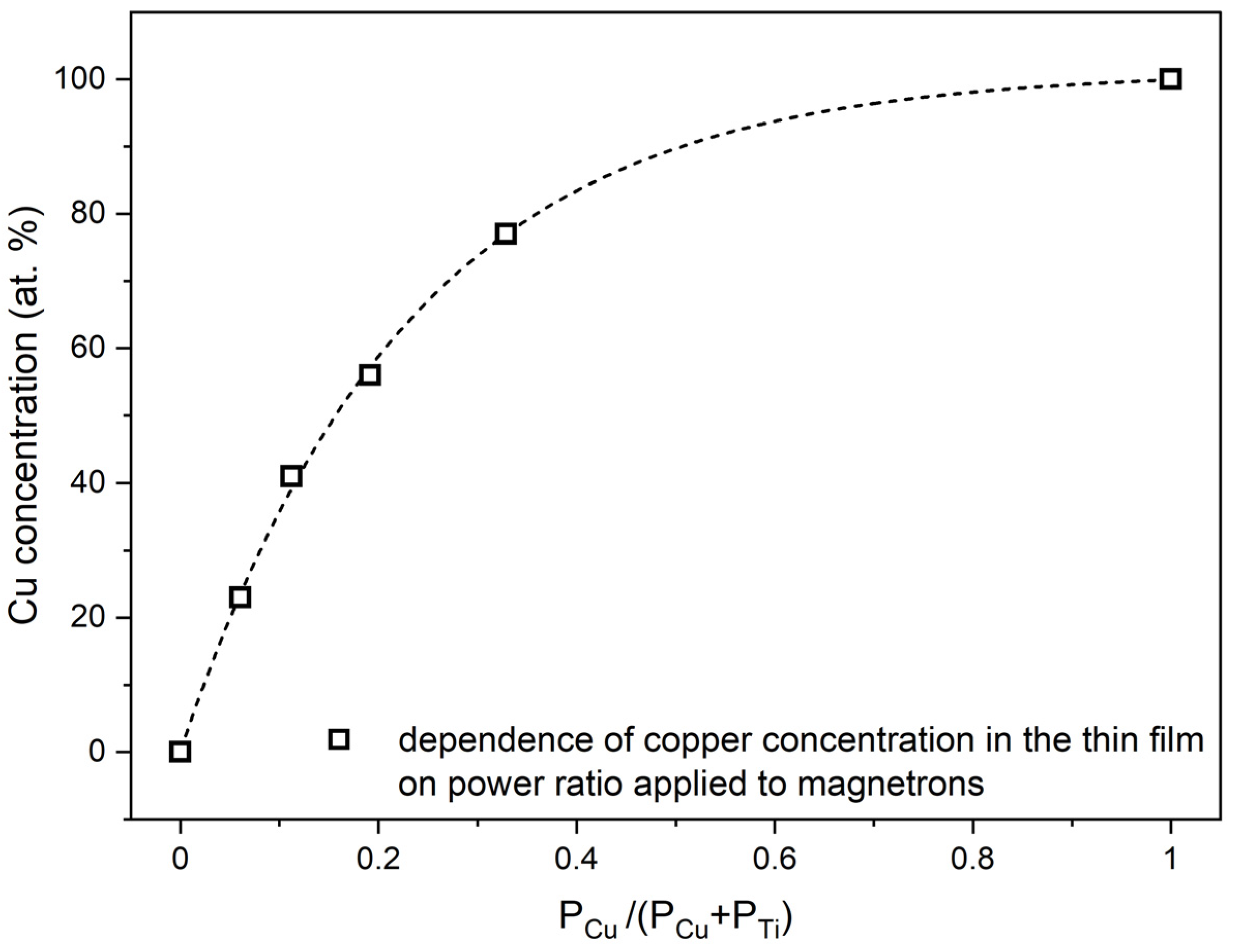
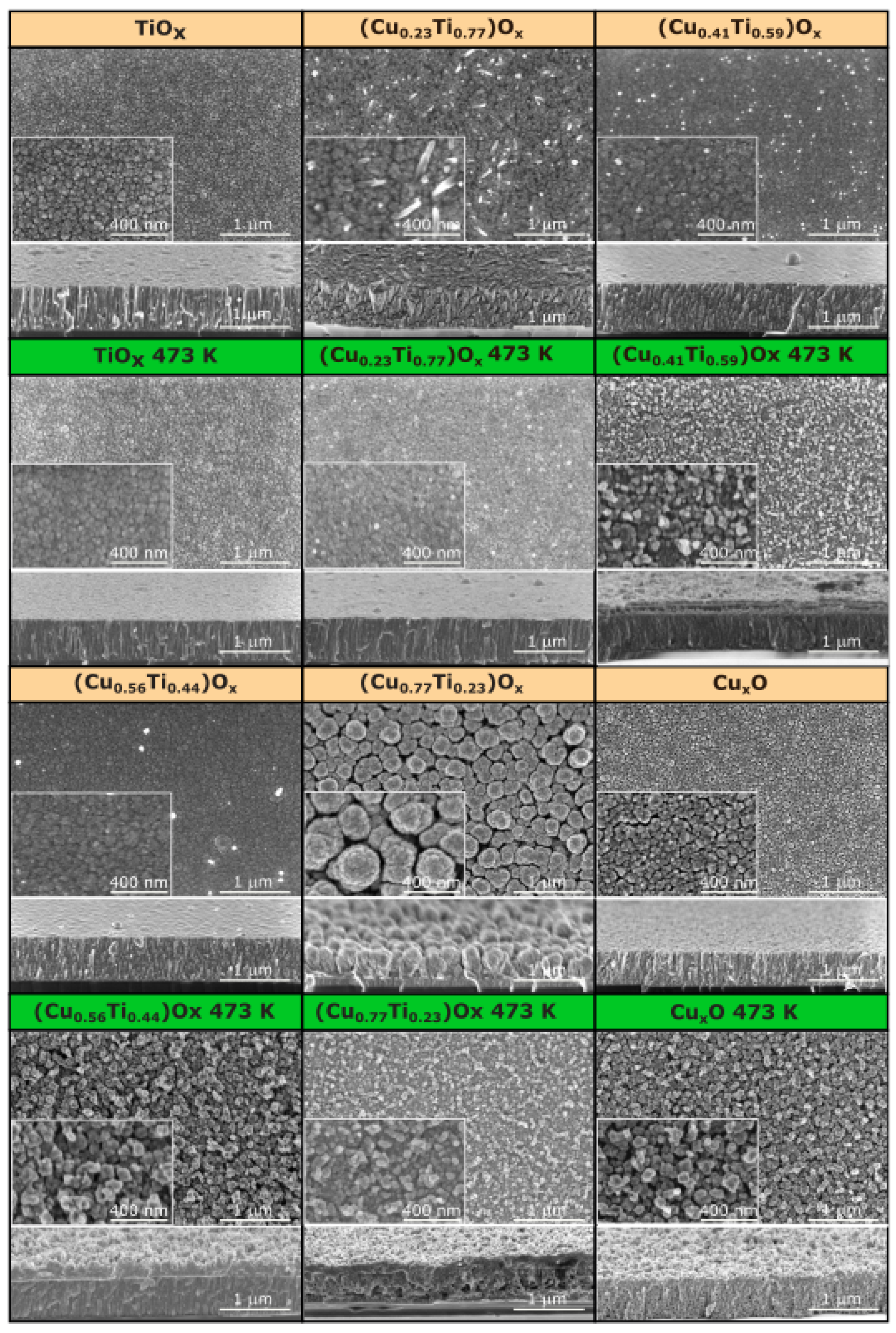
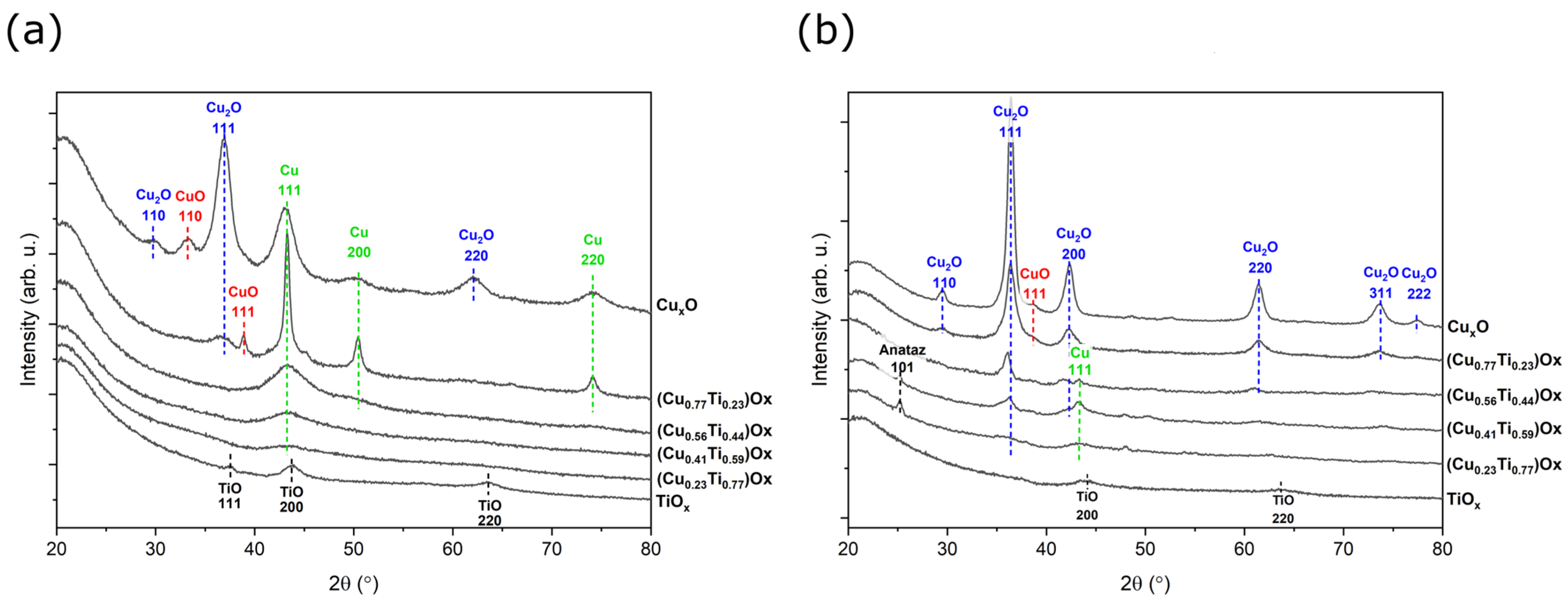
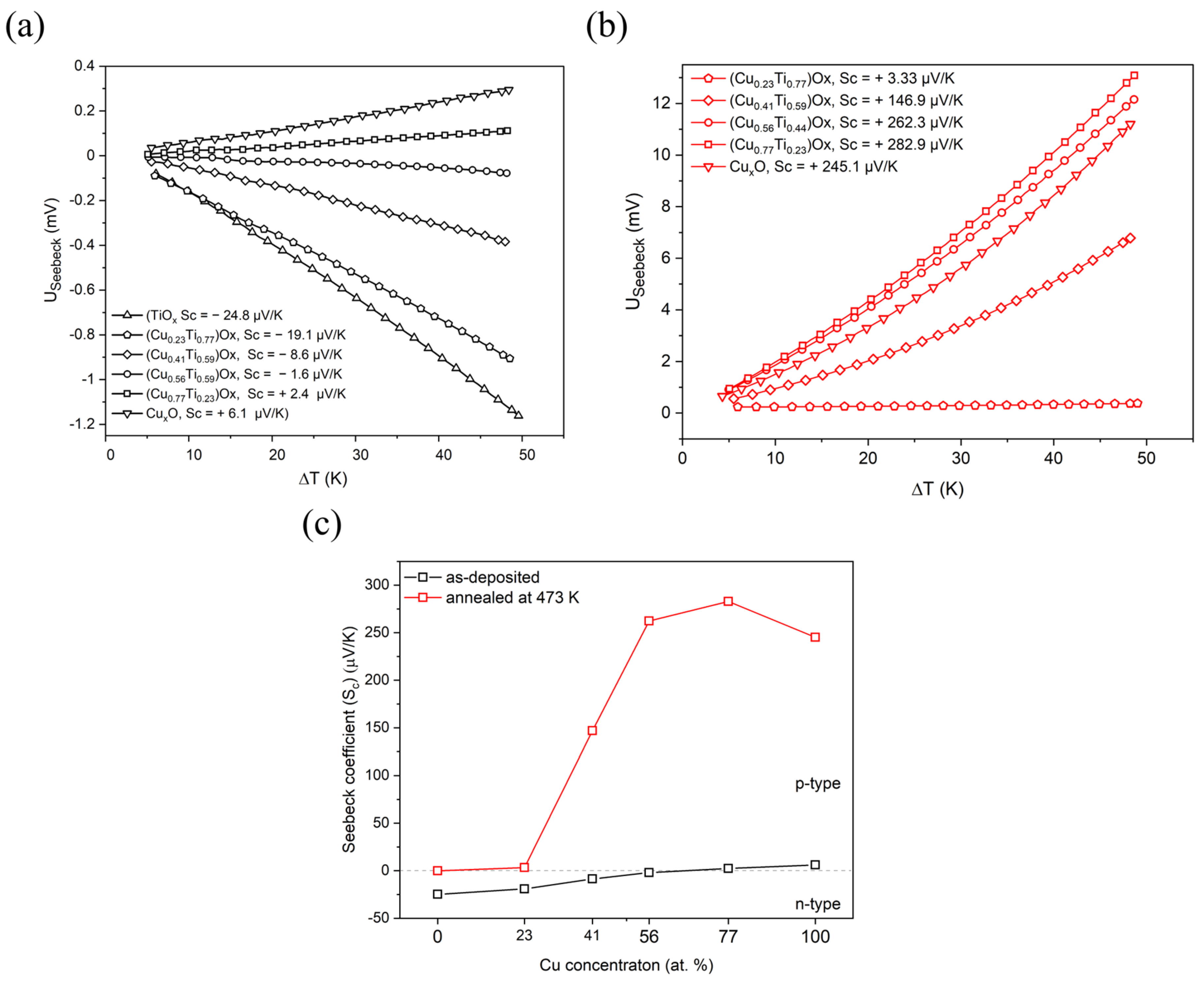
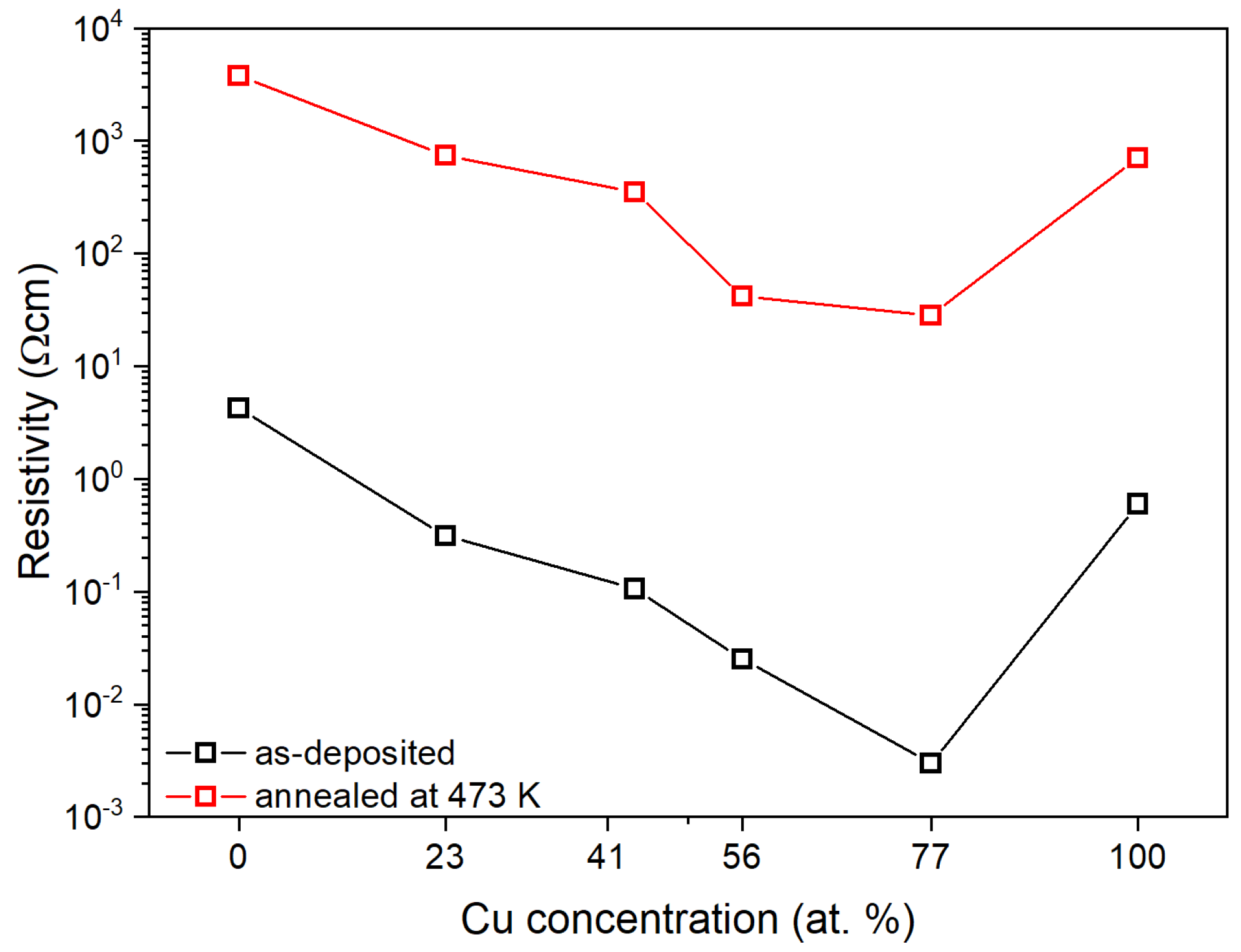
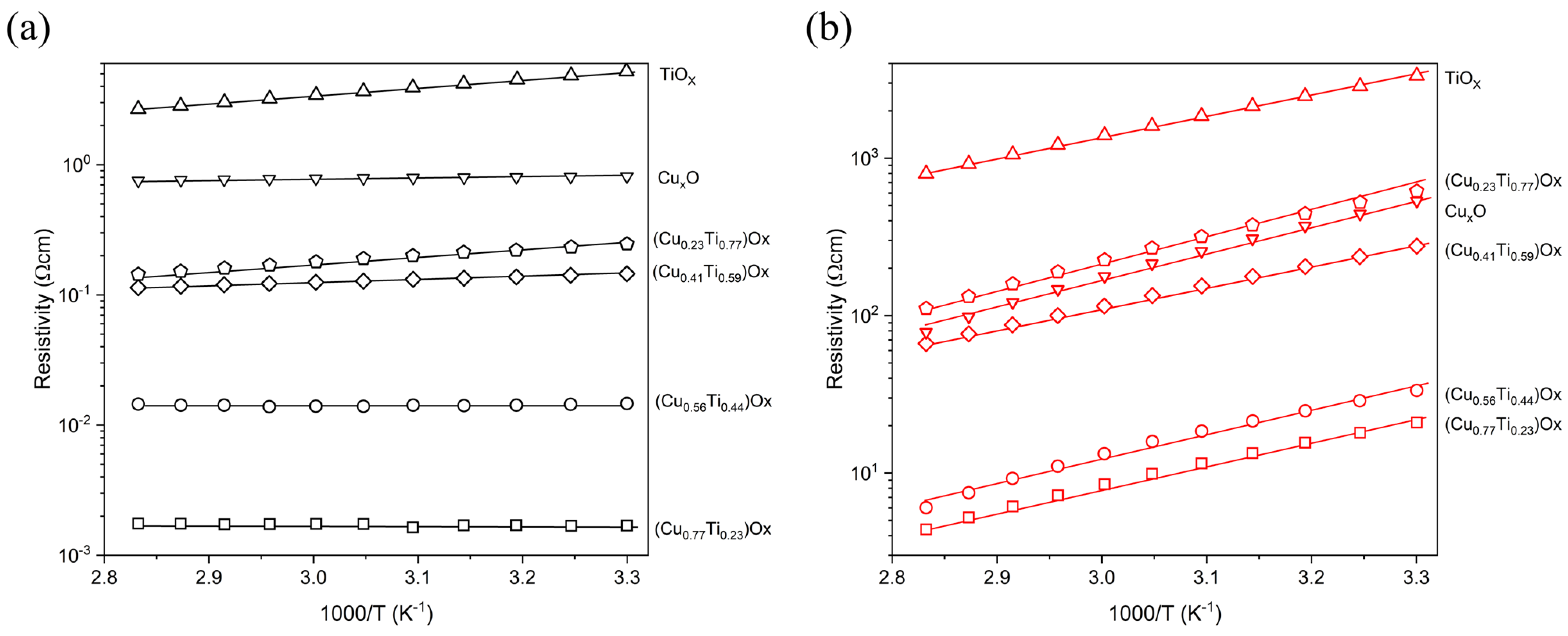

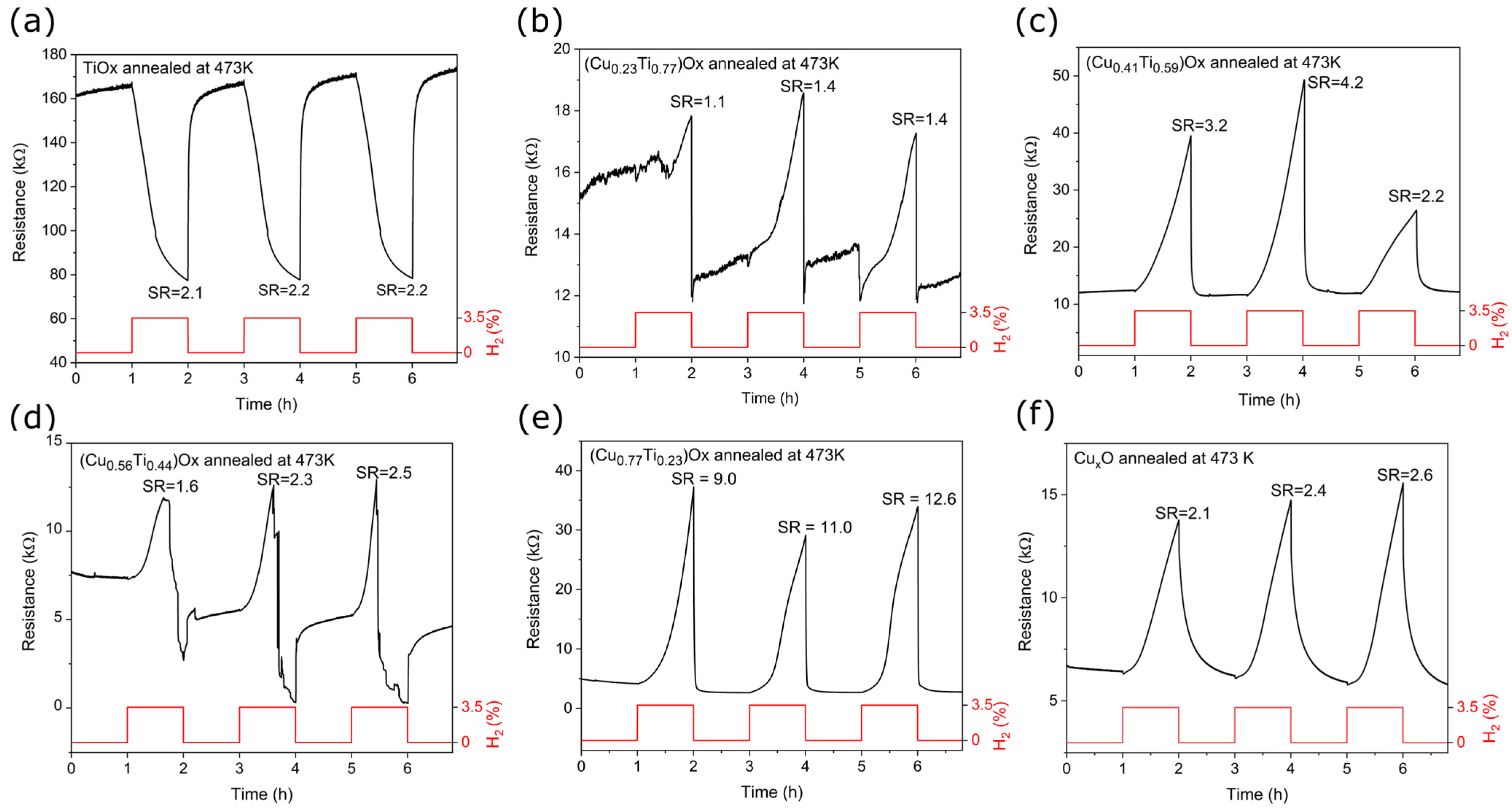
| Thin Film | Deposition Rate (Å/s) | Power Applied to Targets (W) | Distance between Magnetrons and Substrate Holder (cm) | Pressure of Ar + O2 in the Vacuum Chamber (10−2 mbar) | Thickness of the Thin Film (nm) | ||
|---|---|---|---|---|---|---|---|
| Ti | Cu | Ti | |||||
| TiOx | 4.5 | 590 | - | 465 | 10 | 1.25 | 540 |
| (Cu0.23Ti0.77)Ox | 5.7 | 560 | 70 | 520 | 620 | ||
| (Cu0.41Ti0.59)Ox | 6.3 | 525 | 140 | 580 | 570 | ||
| (Cu0.56Ti0.44)Ox | 8.1 | 505 | 140 | 550 | 580 | ||
| (Cu0.77Ti0.23)Ox | 4.8 | 250 | 250 | 260 | 430 | ||
| CuxO | 2.9 | - | 255 | - | 430 | ||
| Thin Film | As-Deposited | Annealed at 473 K | ||||
|---|---|---|---|---|---|---|
| Phase | hkl | D (nm) | Phase | hkl | D (nm) | |
| TiOx | TiO TiO TiO | 111 200 220 | 11.8 5.3 4.9 | TiO TiO | 200 220 | 5.4 4.5 |
| (Cu0.23Ti0.77)Ox | Cu | 111 | 3.1 | TiO2—anatase Cu2O Cu | 101 111 111 | 19.1 5.4 4.8 |
| (Cu0.41Ti0.59)Ox | Cu | 111 | 2.9 | TiO2—anatase Cu2O Cu | 101 111 111 | 26.5 8.4 5.8 |
| (Cu0.56Ti0.44)Ox | Cu | 111 | 3.1 | Cu2O Cu2O Cu | 111 200 111 | 10.7 9.5 21.4 |
| (Cu0.77Ti0.23)Ox | Cu2O CuO Cu Cu Cu | 111 111 111 200 220 | 5.1 20.0 13.4 12.8 13.6 | Cu2O Cu2O CuO Cu2O Cu2O Cu2O | 110 111 111 200 220 311 | 12.2 8.2 17.3 7.2 7.7 6.3 |
| CuxO | Cu2O CuO Cu2O Cu Cu Cu2O Cu | 110 110 111 111 200 220 220 | 8.5 9.0 6.1 4.6 5.3 4.7 5.0 | Cu2O Cu2O CuO Cu2O Cu2O Cu2O Cu2O | 110 111 111 200 220 311 222 | 12.1 11.1 13.4 8.8 8.8 8.5 10.8 |
| Thin Films | Seebeck Coefficient (μV/K) | Resistivity (Ωcm) | Ea (eV/K) | |||
|---|---|---|---|---|---|---|
| As-Deposited | Annealed at 473 K | As-Deposited | Annealed at 473 K | As-Deposited | Annealed at 473 K | |
| TiOx | −24.8 | - | 4.3 | 3.8·103 | 0.12 | 0.26 |
| (Cu0.23Ti0.77)Ox | −19.1 | +3.3 | 3.1·10−1 | 7.4·102 | 0.10 | 0.32 |
| (Cu0.41Ti0.59)Ox | −8.6 | +146.9 | 1.1·10−1 | 3.5·102 | 0.04 | 0.26 |
| (Cu0.56Ti0.44)Ox | −1.6 | +262.3 | 2.5·10−2 | 4.2·101 | 0.00 | 0.26 |
| (Cu0.77Ti0.23)Ox | +2.4 | +282.9 | 3.0·10−3 | 2.8·101 | 0.00 | 0.29 |
| CuxO | +6.1 | +249.1 | 6.0·10−1 | 7.1·102 | 0.01 | 0.35 |
| Thin Film | Operating Temperature | Concentration of Target Gas | SR | tresponse (min) | trecovery (s) |
|---|---|---|---|---|---|
| TiOx | 473 K | 3.5% H2 | 2.2 ± 0.1 | 36 ±1 | 322 ± 31 |
| (Cu0.23Ti0.77)Ox | 1.3 ± 0.1 | 56 ± 1 | - | ||
| (Cu0.41Ti0.59)Ox | 3.8 ± 1.1 | 56 ± 2 | 187 ± 146 | ||
| (Cu0.56Ti0.44)Ox | 2.1 ± 0.4 | - | - | ||
| (Cu0.77Ti0.23)Ox | 10.9 ± 1.5 | 56 ± 1 | 67 ± 14 | ||
| CuxO | 2.4 ± 0.2 | 55 ± 1 | 1444 ± 79 |
| Structure | Preparation Method | H2 Concentration (ppm) | Working Temperature (K) | SR | Ref. |
|---|---|---|---|---|---|
| CuO-TiO2 nanocomposites | Chemical vapor deposition | 1000 | 473–673 | 2–0.4 | [23] |
| TiO2 decorated CuO nanorods | Thermal oxidation and solvothermal method | 0.1–5 | 573 | 1.94–8.57 | [48] |
| CuO/TiO2−y heterostructure | MF magnetron sputtering | 10–320 | 573–673 | 1.0–1.5 | [61] |
| CuO thin film/TiO2 nanotubes | Electrochemical anodization, thermal evaporation, oxidation | 100–1000 | 373–473 | 2.0 | [63] |
| TiO2/CuxO | Spray pyrolysis, magnetron sputtering, annealing | 100 | 523–623 | 0.2–0.6 | [65] |
| Li-doped CuO-TiO2 heterostructure | Ion beam sputtering, annealing | 1000 | 573 | 1.16 | [22] |
| TiO2-CuO (50%–50% and (25%–75%) | Ion beam sputtering, annealing | 100 | 573 | 0.98 | [21] |
| mixed (CuTi)Ox | Magnetron sputtering | 35,000 | 473 | 1.3–10.9 | This work |
Disclaimer/Publisher’s Note: The statements, opinions and data contained in all publications are solely those of the individual author(s) and contributor(s) and not of MDPI and/or the editor(s). MDPI and/or the editor(s) disclaim responsibility for any injury to people or property resulting from any ideas, methods, instructions or products referred to in the content. |
© 2023 by the authors. Licensee MDPI, Basel, Switzerland. This article is an open access article distributed under the terms and conditions of the Creative Commons Attribution (CC BY) license (https://creativecommons.org/licenses/by/4.0/).
Share and Cite
Mańkowska, E.; Mazur, M.; Domaradzki, J.; Wojcieszak, D. P-type (CuTi)Ox Thin Films Deposited by Magnetron Co-Sputtering and Their Electronic and Hydrogen Sensing Properties. Coatings 2023, 13, 220. https://doi.org/10.3390/coatings13020220
Mańkowska E, Mazur M, Domaradzki J, Wojcieszak D. P-type (CuTi)Ox Thin Films Deposited by Magnetron Co-Sputtering and Their Electronic and Hydrogen Sensing Properties. Coatings. 2023; 13(2):220. https://doi.org/10.3390/coatings13020220
Chicago/Turabian StyleMańkowska, Ewa, Michał Mazur, Jarosław Domaradzki, and Damian Wojcieszak. 2023. "P-type (CuTi)Ox Thin Films Deposited by Magnetron Co-Sputtering and Their Electronic and Hydrogen Sensing Properties" Coatings 13, no. 2: 220. https://doi.org/10.3390/coatings13020220
APA StyleMańkowska, E., Mazur, M., Domaradzki, J., & Wojcieszak, D. (2023). P-type (CuTi)Ox Thin Films Deposited by Magnetron Co-Sputtering and Their Electronic and Hydrogen Sensing Properties. Coatings, 13(2), 220. https://doi.org/10.3390/coatings13020220








